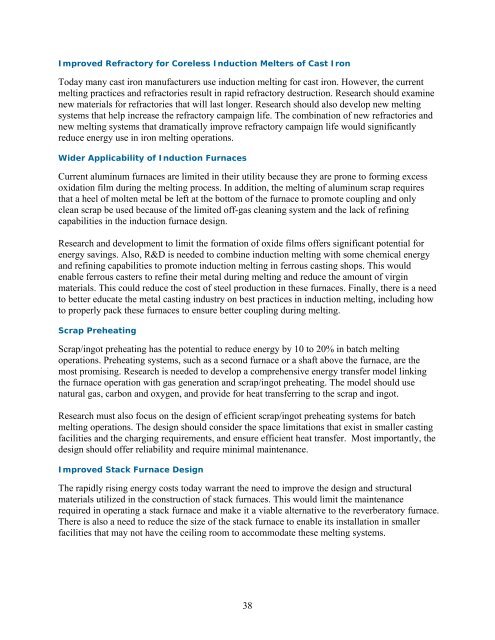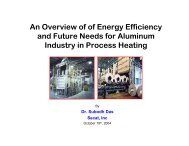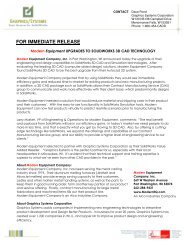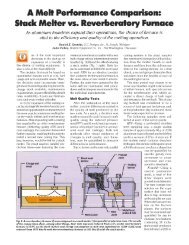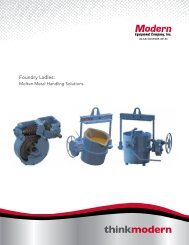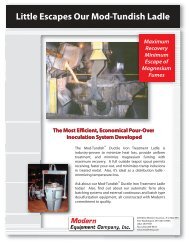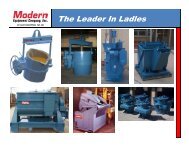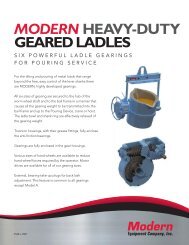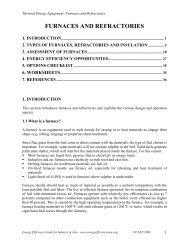ITP Metal Casting: Advanced Melting Technologies: Energy Saving ...
ITP Metal Casting: Advanced Melting Technologies: Energy Saving ...
ITP Metal Casting: Advanced Melting Technologies: Energy Saving ...
You also want an ePaper? Increase the reach of your titles
YUMPU automatically turns print PDFs into web optimized ePapers that Google loves.
Improved Refractory for Coreless Induction Melters of Cast Iron<br />
Today many cast iron manufacturers use induction melting for cast iron. However, the current<br />
melting practices and refractories result in rapid refractory destruction. Research should examine<br />
new materials for refractories that will last longer. Research should also develop new melting<br />
systems that help increase the refractory campaign life. The combination of new<br />
refractories and<br />
new melting systems that dramatically improve refractory campaign life would significantly<br />
reduce energy use in iron melting operations.<br />
Wider Applicability of Induction Furnaces<br />
Current aluminum furnaces are limited in their utility because they are prone to forming excess<br />
oxidation film during the melting process. In addition, the melting of aluminum scrap requires<br />
that a heel of molten metal be left at the bottom of the furnace to promote coupling and only<br />
clean scrap be used because of the limited off-gas cleaning system and the lack of refining<br />
capabilities in the induction furnace design.<br />
Research and development to limit the formation of oxide films offers significant potential for<br />
energy savings. Also, R&D is needed to combine induction melting with some chemical energy<br />
and refining capabilities to promote induction melting in ferrous casting shops. This would<br />
enable ferrous casters to refine their metal during<br />
melting and reduce the amount of virgin<br />
materials.<br />
This could reduce the cost of steel production in these furnaces. Finally, there is a need<br />
to better educate the metal casting industry on best practices in induction melting, including how<br />
to properly pack these furnaces to ensure better coupling during melting.<br />
Scrap Preheating<br />
Scrap/ingot preheating has the potential to reduce energy by 10 to 20% in batch melting<br />
operations. Preheating systems, such as a second furnace or a shaft above the furnace, are the<br />
most promising. Research is needed to develop a comprehensive energy transfer model<br />
linking<br />
the furnace operation with gas generation and scrap/ingot preheating. The model should use<br />
natural gas, carbon and oxygen, and provide for heat transferring to the scrap and ingot.<br />
Research must also focus on the design of efficient scrap/ingot preheating systems for batch<br />
melting operations. The design should consider the space limitations that exist in smaller casting<br />
facilities and the charging requirements, and ensure efficient heat transfer. Most importantly,<br />
the<br />
design should offer reliability and require minimal maintenance.<br />
Improved Stack Furnace Design<br />
The rapidly rising energy costs today warrant the need to improve the design and structural<br />
materials utilized in the construction of stack furnaces. This would limit the maintenance<br />
required in operating a stack furnace and make it a viable alternative<br />
to the reverberatory furnace.<br />
There is also a need to reduce the size of the stack furnace to enable its installation in smaller<br />
facilities that may not have the ceiling room to accommodate these melting systems.<br />
38


